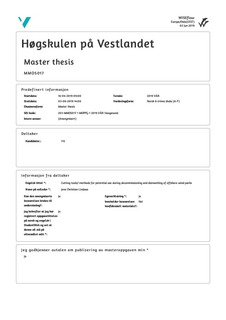| dc.contributor.author | Mæland, Børre | |
| dc.date.accessioned | 2019-09-09T11:38:30Z | |
| dc.date.available | 2019-09-09T11:38:30Z | |
| dc.date.issued | 2019 | |
| dc.identifier.uri | http://hdl.handle.net/11250/2614305 | |
| dc.description | WESTERN NORWAY UNIVERSITY OF APPLIED SCIENCES Master Thesis in Master of Maritime Operations | nb_NO |
| dc.description.abstract | The first offshore wind turbine park was built in the nineties and the first was decommissioned in 2001. Since the nineties, the building of offshore wind turbine park has developed to a mature industry, decommissioning is however not mature and there is room for development. The oil & gas industry has long experience with decommissioning and one of the goals for the project is to use experience from the oil & gas industry to develop tools/-methods for decommissioning of offshore wind turbines.
This paper is a part of the Decom Tools project, this is a project funded by Interreg North Sea Region, a European regional Development Found. The aim of the project is to reduce the decommissioning cost by 20% and the environmental footprint by 25% (measured in CO2 equivalents). The base case for measuring cost and environmental footprint is a reverse installation of offshore wind turbines. The task for the work with this paper is to use experience with cutting tools/-methods from oil & gas and use them to develop cutting tools/-methods for decommissioning of offshore wind turbines. Sheringham Shoal offshore wind park and the decommissioning paper provided by Equinor was used as a base case for this paper, tools/- methods used in the decommissioning paper was compared with the experience from the companies and new tools/-methods proposed by the writer. Sheringham Shoal offshore wind park is located in the UK, and the solutions presented are based on UK law and regulation.
Four companies working in the oil & gas industry was consulted to gather experience. Two of the companies was contractors and two was working with decommissioning of offshore oil & gas structures. Members of the Decom tools project visited the companies for a workshop. A questionnaire provided by the Decom Tools project was sent to the companies in advance for our visit and workshop with the companies.
The experience from the companies was compared and used to develop a new tool/-method for decommissioning of offshore wind turbine foundation. The method is based on the companies preference for diamond wire saw and their aversion against dredging. The new method is to cut the monopile on the seafloor with a diamond wire saw and drive the monopile further down in the seabed with a hydraulic hammer. | nb_NO |
| dc.language.iso | eng | nb_NO |
| dc.publisher | Høgskolen på Vestlandet | nb_NO |
| dc.rights | Navngivelse 4.0 Internasjonal | * |
| dc.rights.uri | http://creativecommons.org/licenses/by/4.0/deed.no | * |
| dc.title | Cutting tools/-methods for potential use during decommissioning and dismantling of offshore wind parks | nb_NO |
| dc.type | Master thesis | nb_NO |
| dc.description.localcode | MMO5017 | nb_NO |

